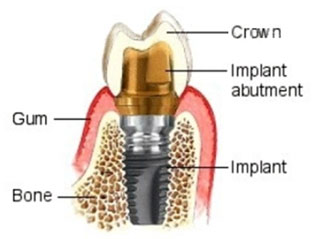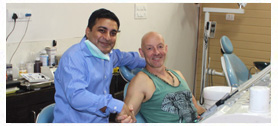An implant-restored tooth consists of several parts.
- The implant, which is made of titanium, is placed in the upper or lower jawbone.
- The abutment can be made of titanium, gold or porcelain. It is attached to the implant with a screw. This part connects the implant to the crown.
- The restoration (the part that looks like a tooth) is a crown, usually made of porcelain fused to a metal alloy (PFM), but also could be an all-metal or all-porcelain crown. The crown is attached either to the abutment or directly to the implant. It can be screwed or cemented onto the abutment. If the crown is screwed to the abutment, the screw hole will be covered with restorative material such as tooth-colored filling material (composite).
The Implant Process
The time frame for completing the implant and crown depends on many factors.
- Implant-supported crowns are a naturally better solution.
- Looks, feels and performs similar to your natural tooth
- Does not compromise your adjacent teeth to support a bridge
- Preserves surrounding bone (replaces tooth root)*
- Prevents bone collapse and jaw line recession*
- Oral care same as a natural tooth
- Restores a more secure biting ability than a removable denture
- Restores self-confidence and appearance
The Implant Process
Initial consultation
 Before
any work is done, you will visit our Implantologist who
has had advanced training in the placement and
restoration of implants will do a comprehensive
examination. During the exam, he or she will review your
medical and dental history, take X-rays, and create
impressions of your teeth and gums so that models can be
made. In some cases, the dentist also may order a
computerized tomography (CT) scan of your mouth. This
scan will help your dentist determine how much jawbone
is available to hold the implants in place, and will
show the location of structures such as nerves and
sinuses (located above your upper teeth) so they can be
avoided during surgery. If the X-rays show that your jaw
does not have enough bone to hold an implant, the
dentist can discuss options, such as bone grafting and
bone distraction, for building up the bone. If you need
one of these procedures.
Before
any work is done, you will visit our Implantologist who
has had advanced training in the placement and
restoration of implants will do a comprehensive
examination. During the exam, he or she will review your
medical and dental history, take X-rays, and create
impressions of your teeth and gums so that models can be
made. In some cases, the dentist also may order a
computerized tomography (CT) scan of your mouth. This
scan will help your dentist determine how much jawbone
is available to hold the implants in place, and will
show the location of structures such as nerves and
sinuses (located above your upper teeth) so they can be
avoided during surgery. If the X-rays show that your jaw
does not have enough bone to hold an implant, the
dentist can discuss options, such as bone grafting and
bone distraction, for building up the bone. If you need
one of these procedures.
First Visit - implant placement
Once you have enough bone to successfully hold an implant, you will schedule the first surgery, which involves placing the implant or implants in your jaw. Our Implantologist usually does this surgery, and stays in close contact with your prosthodontist or general dentist. Although there are several types of implants, the most popular type is root-form implants designed to serve as the root of the tooth. They are placed in the jawbone in the space created by the missing tooth. We wait till the bone and the implants fuse.
Second Visit and placement of healing collar and/or temporary crown
Once the implants have become fused with the bone, you can schedule the second appointment. Your dentist will confirm whether the implant is ready by taking an X-ray.
Healing after second-stage surgery
 A
collar, called a healing abutment (collar), is placed on
the head of the implant after it is exposed. This
encourages the gums to heal correctly. The collar is a
round piece of metal that holds the gums away from the
head of the implant. The collar will be in place for 10
to 14 days. If you previously had a removable partial
denture, your dentist may adjust it so you can use it
during this time.
A
collar, called a healing abutment (collar), is placed on
the head of the implant after it is exposed. This
encourages the gums to heal correctly. The collar is a
round piece of metal that holds the gums away from the
head of the implant. The collar will be in place for 10
to 14 days. If you previously had a removable partial
denture, your dentist may adjust it so you can use it
during this time.
Healing abutments help the gums to heal properly After the stitches and collar are removed, final impressions are made. These impressions will be used to make models that will look exactly like your mouth. A dental technician will use these models to make the temporary and final crowns.
An abutment and temporary crown are placed on the implant. The abutment is screwed onto the implant and tightened, using special equipment so that it won't come loose. After the abutment is attached to the implant, the temporary crown is placed on the abutment. In some cases, the temporary crown is attached directly to the implant without an abutment. The abutment then is placed later. In other cases, you may get the abutment and temporary crown immediately after the implants are uncovered during the second surgery, and you won't need a healing collar. The gums will heal around it and will look like the gums around your natural teeth. The temporary crown is made of softer material than the permanent crown. The softer material helps to cushion and protect the implant from the pressure of chewing, and gives the jawbone the opportunity to gradually get stronger.
Placement of permanent crowns
While you are wearing your temporary crown, the permanent crown will be made. The crown can be created from a model of your teeth and gums that includes the implant or the abutment. The crown can be either cemented or screwed to the abutment. Crowns held in place by cement may look better because there is no screw hole in the crown to be seen. However, crowns held in place by a screw are easier for your dentist to remove if he or she needs to reach the implant or the tissue around the implant. Sometimes, an abutment can't be used. In that case, your dentist would attach the crown with a screw.
Caring for Your Implants
You care for your implants the same way you care for your natural teeth.
It is important to brush and floss daily.
You will need to visit your dentist every three months for checkups at first, but eventually you can have checkups every six months.
What Will X-Rays Show?
On an X-ray, you will be able to see the implant in the bone, the connection between the implant and the abutment, and the abutment and the crown.
Your dentist can look at how the implant, abutment and crown fit together and make sure that there are no problems.
Single-tooth implants will work and look like your natural teeth.
Dental Care

Regular dental care is an important part of oral health. Having healthy teeth and gums isn't a given, though.

Dental Tourism

Our dental tourism packages, transport you to the world of royalty in all its regal splendor. An experience of a lifetime awaits you...

Brushing your teeth

Your teeth are meant to last a lifetime! Tooth decay, or cavities, and periodontal disease, also known as gum disease, can ..

Oral Health Problems

If one or more of your teeth are missing, there are a number of ways to replace them. An alternative to bridges, partials or complete...

Patient Gallery

Here's just a few "before-and-after" photos of some of our most common procedures. Come in and see how we can enhance your smile.


